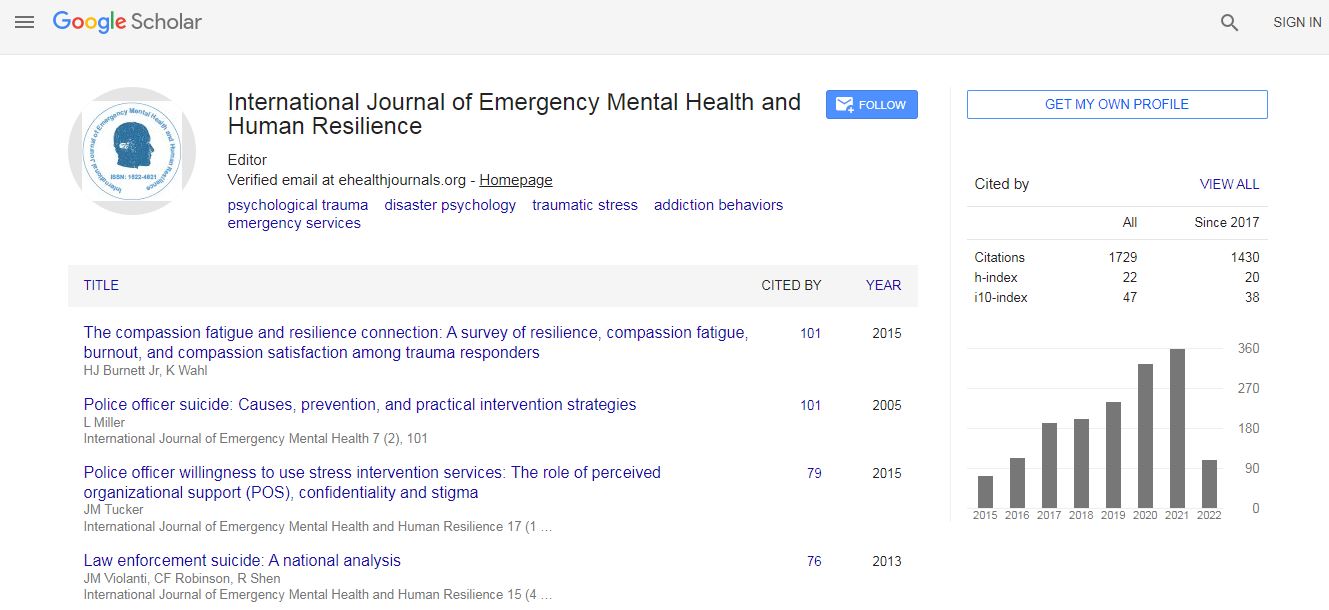Our Group organises 3000+ Global Conferenceseries Events every year across USA, Europe & Asia with support from 1000 more scientific Societies and Publishes 700+ Open Access Journals which contains over 50000 eminent personalities, reputed scientists as editorial board members.
Open Access Journals gaining more Readers and Citations
700 Journals and 15,000,000 Readers Each Journal is getting 25,000+ Readers
Google Scholar citation report
Citations : 4948
Indexed In
- Index Copernicus
- Google Scholar
- CiteFactor
- Publons
- Pubmed
- science Gate
- scispace
- world cat
Useful Links
Related Subjects
Share This Page
Can an e-recovery portal play a role in shifting practices towards recovery?
3rd International Conference on Mental Health and Human Resilience
Deede Gammon, Monica Strand, Eng, Borosund, Varsi and Ruland
Oslo University Hospital, Norway
ScientificTracks Abstracts: Int J Emerg Ment Health
Abstract
Background: Mental health care for those persons with persistent care needs is shifting from a primary focus on symptom reduction towards personal recovery-oriented care. Web-based portals may facilitate this shift, but little is known about how such tools will be used, or the role they may play in personal recovery. Objective: Describe the use of and experiences with the e-recovery portal ReConnect as an adjunct to ongoing community mental health care and explore its potential role in shifting practices towards recovery. Methods: ReConnect was introduced into two Norwegian community mental health care services which used it for six months with the aim of supporting personal recovery and between service users and health care providers. Inclusion criteria were long-term care needs, at least one provider willing to interact with users through ReConnect. The portal augmented ongoing collaboration as each service user├?┬ó├?┬?├?┬?provider dyad found appropriate, and comprised of: (1) a toolbox of resources for articulating and monitoring recovery processes, e.g., status/goals/activities relative to life domains (e.g., employment, social network and health), medications, network map and exercises (e.g., sleep hygiene and mindfulness), (2) secure messaging with providers having partial access to toolbox content, (3) a peer support forum. Quantitative data (system log and questionnaires) were analyzed using descriptive statistics. Qualitative data (e.g., focus groups and forum postings) are presented relative to the four common denominators of recovery-oriented practices; personally defined recovery, promoting citizenship, working relationships and organizational commitment. Results: 56 participants (29 service users and 27 providers) made up 29 service user-provider dyads/teams. Service users reported having 11 different mental health diagnoses with an average of two diagnoses each (range 1-7). The 27 providers represented nine different professional backgrounds. Forum was the most frequently used module with 1870 visits and 542 postings. Service users control over toolbox resources (e.g., defining and monitoring personal goals), along with the 24/7 availability of peer-support, activated service users in their personal recovery processes and in community involvement. The collaborating dyads used the portal resources in highly diverse ways and both service users and providers reported needing more than six months to discover and adapt optimal uses relative to their individual and collaborative needs. The community with policies committed to recovery-oriented care pursued implementation of ReConnect as a permanent service following the six months, while the other declined. Conclusions: Regardless of providers├?┬ó├?┬?├?┬? portal use, service users├?┬ó├?┬?├?┬? control over toolbox resources, coupled with peer-support offered an empowering common frame of reference that represented an immediate shift towards recovery-oriented practices within communities. While service users├?┬ó├?┬?├?┬? autonomous use of the portal could eventually influence providers in the direction of recovery practices, a fundamental shift is unlikely without broader organizational commitments aligned with recovery principles, e.g., quantified goals for service user involvement in action plans.Biography
Deede Gammon is a Psychologist and a Senior Scientist at Norwegian Centre for Telemedicine (NST), University Hospital in North-Norway and at Oslo University Hospital. She has also been an Associate Professor at University of Tromsø and a Guest Scientist at University of Oregon, USA. She has headed numerous interdisciplinary ehealth research projects, particularly with a focus on patients’ and the public’s use of information and communication technologies (ICT) to cope with illness.
Email: deede.gammon@rr-research.no

 Spanish
Spanish  Chinese
Chinese  Russian
Russian  German
German  French
French  Japanese
Japanese  Portuguese
Portuguese  Hindi
Hindi 